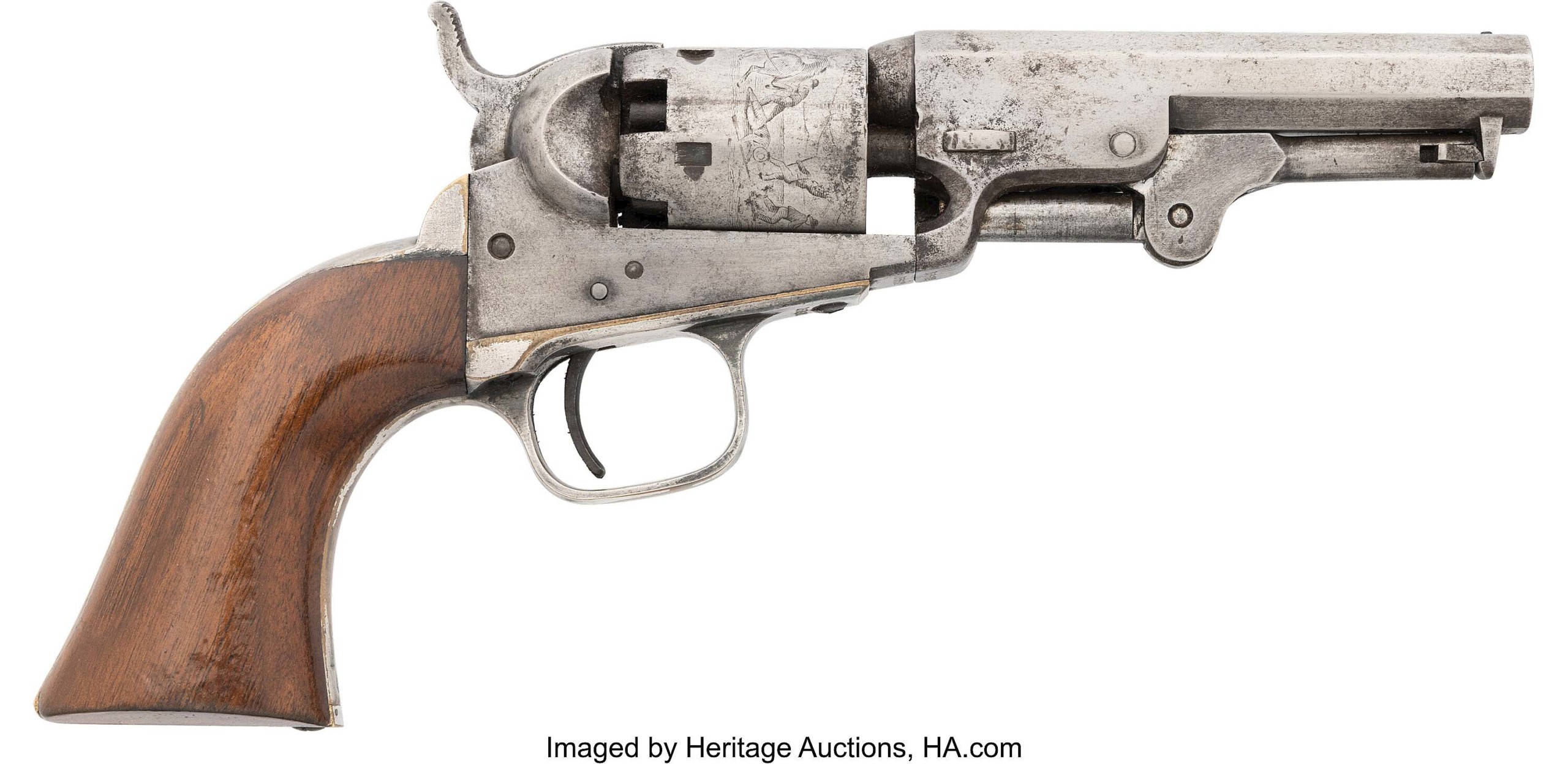
Shooting to the top of the sale was this 1859 Colt Model 1849 Pocket Percussion Revolver that belonged to Dr Edmund Lewis Massie, a Confederate Army surgeon. In “very good condition,” the gun was claimed for $27,500.
Review by Carly Timpson
DALLAS — On December 9, Heritage Auctions brought forth 698 lots for its Arms & Armor, Civil War & Militaria sale. The auction, which featured several early Colt guns, historic family memorabilia, flags, documents and Grand Army of the Republic (G.A.R.) items from the collection of Don Limpert, realized $783,151 in total.
Claiming the sale’s highest price — $27,500 — was a Colt Model 1849 Pocket Percussion Revolver manufactured in 1859. This weapon belonged to Dr Edmund Lewis Massie, a surgeon for the Confederate Army, and its backstrap bore an inscription that read, “Edmund L. Massie, M.D.” The .31 caliber gun had a 4-inch octagonal barrel with a blued and case-hardened finish. Etched on the cylinder was a lively battle scene featuring men and their horses and carriages.
In the second spot was a knife by California maker Michael Price. The auction catalog noted that he was “one of the most renowned knifemakers in Nineteenth Century America, particularly noted for his high-quality handcrafted knives produced in San Francisco.” The example in this auction was marked “M. Price / San Fran” and its handle was intricately inlaid with a mosaic of abalone shell and silver. The handle’s wrapped edges and the guard were also silver, as was the matching scabbard. Having a 5¾-inch spearpoint blade, the knife was stabbed down for $23,750.

This abalone mosaic spearpoint knife, marked for Michael Price, San Francisco, Ninteeenth Century, had a 5¾-inch blade and a matching silver-plated scabbard; it brought $23,750.
A .45 caliber Single Action Army Revolver from 1873, the first year Colt produced the model, brought $18,750. It had a 7-3/8-inch barrel with a blued finish and a one-piece walnut grip. The gun was sold with an assortment of documents including a November 1981 layaway receipt from Jackson Arms (Dallas), correspondence from Colt in response to Champ G Wilson’s request for more information regarding the model and a November 2024 letter from Colt Single Action Revolver expert and historian, Charles B. Layson. Layson’s letter closes with the following: “It is a good example of a very early Peacemaker that has been cleaned and polished to improve its appearance. Very few examples of these first months of Single Action production are available to study, and I appreciate this opportunity.”
Made by the Confederate manufacturer Read & Watson, a .54 caliber percussion rifle with a bronze breech and walnut stock achieved $15,000. According to the auction catalog, “the Read & Watson Percussion Rifle is a rare and intriguing firearm from the American Civil War, notable for its craftsmanship and the circumstances of its production. Read & Watson was a smaller operation compared to other Confederate armories.” This example was in very good condition, having a bright gray patina.
Also bringing $15,000 was a wood drum canteen that chronicled three generations of Virginians through three wars. This mundane artifact, made unusual by its carvings, “represents the saga of a family and a nation.” To one of its round sides, the names and dates of three men were listed: Lieutenant Francis Boykin (1777), Lieutenant Colonel Francis M. Boykin (1813) and Colonel Francis Marshall Boykin (1861). The three men served in the American Revolution, the War of 1812 and the Civil War respectively. According to the auction catalog, “The canteen has no visible strap loops or any provision to be carried” and its “age has given it a pleasing uniform dark patina.”

Three generations of the Boykin family from 1777 to 1865 were identified in carvings on the surface of this wooden drum canteen, 5½ inches in diameter by 5½ inches high with a ¾-inch bunghole; it was bid to $15,000.
A silver goblet awarded to a pilot of the Imperial German Air Service in World War I also raised $15,000. The goblet’s central motif was of two eagles in aerial combat and it was impressed with the motto “Dem Sieger im Luftkampf (The Victor in the Air Battle)” around the base. Its underside was marked with the stamp of Chef des Feldflugwesensans and it sat atop four ball feet. The auction catalog noted that there are thought to be around 2,411 of these awards given during World War I. This example was from the collection of Jonathan Kern and was sold to benefit charity.
Prices quoted include the buyer’s premium as reported by the auction house. For information, www.ha.com or 877-437-4824.












